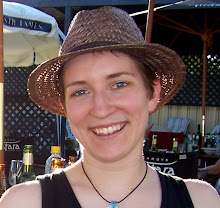
One of the most common modes of short distance transport in Bangladesh is the rickshaw. This is like a 3-wheeled bike, with the rider at the front and a bench seat with a retractable hood (like on a baby's pram) at the back. Rickshaws are not only for transporting people (and I've seen as many as 5 adults on the one rickshaw) but also animals, bicycles (as I myself have done), larger quantities of food, household items etc.

It is beyond the scope of this little blog to make any comment on the ethics of rickshaws - the drivers are hideously underpaid (average wage would be about 2000tk or AUD$40 per month) and it can be pretty demeaning work. On the other hand, the traffic pollution and congestion in Dhaka would be so much worse if there weren't the estimated 1 million rickshaws on its roads. And it terms of trying to ban rickshaws (as is often debated), there needs to be a pretty comprehensive plan in place for what these 1 million men are going to do for work instead.
Personally, I quite like riding in rickshaws especially on quiet country roads when there's hardly any sound and you're slowly passing endless green fields of rice. I do, however, refuse to let a rickshawala get off to walk me up a hill (cos the bikes don't have gears, they can't go up anything steeper than a short gentle slope).

Bangladesh is famous for its rickshaw art - painted panels, patterned vinyl covering the seat & hood and as many extra adornments as the owner or driver (cos most guys don't own their rickshaw but rent it for the day) can afford. When I first arrived, I wasn't that rapt in the rickshaw art, but as time goes by I am coming to love it more and more. It was something I hadn't fully appreciated until I went to Nepal and India, where they also have rickshaws. If people think the cycle rickshaws are inhumane, they should check out the hand-held ones powered by barefoot men running through the streets of Kolkata... that was a sight that made my tummy turn a bit. Anyway - these rickshaws look so boring compared to the ones in Bangladesh where rickshawalas often take an enormous amount of pride in the presentation of their chariot. I'm sure Dhaka would be far less tolerable if it wasn't packed to the gills with brightly decorated rickshaws colouring the streets and adding some visual interest among the grey concrete buildings.
A rickshawala is a guy who rides (or drives, as some say) a rickshaw. They are among the poorest of the poor people in Bangladesh and work long hours at one of the most physically demanding jobs for very little pay. To see these guys struggling through the streets during Ramadan, when most of them are fasting from sunrise to sunset, would arouse sympathy in even the most hard-hearted Hannah. The rickshawalas typically wear a lunghi (which is a tube of fabric worn like a sarong) and a shirt, many of which are so hideously ugly that they're fantastic. Some of the other volunteers have wanted to offer money on the spot to buy the shirt off the rickshawala's back.
It is an extra treat when you score a rickshawala who sings. This was recently turned into a "Rickshawala Idol" (not it's real name, but I reckon that's a better name than the one they came up with) contest - a singing contest for rickshawalas.
And here is the winner - in one of the rare times that Bangladesh makes it into international media for something other than a natural disaster or the latest political fiasco:

No comments:
Post a Comment